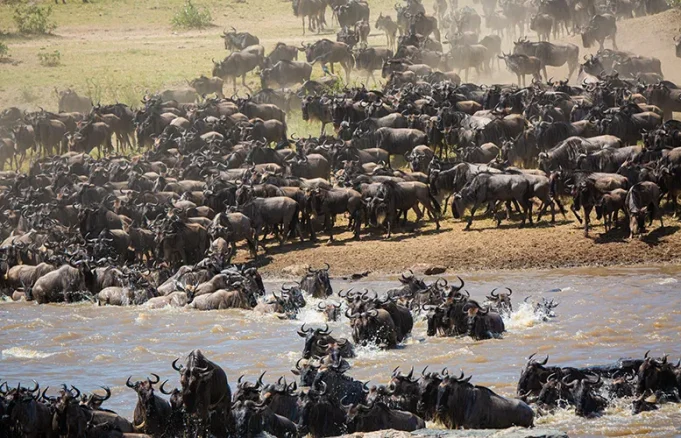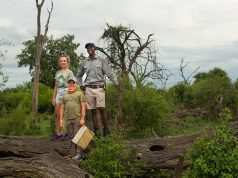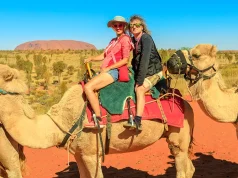Suppose you think of the great Wildebeest Migration. In that case, you’d be forgiven for thinking that it’s a massive herd of wildebeest traveling from A to B over a short distance, and you’ve got to be at a specific place at a particular time to witness it. In reality, the herds are constantly migrating in a generally clockwise route, month by month. So here’s The Great Migration made simple, so you can pick up the key points and plan your trip to coincide with one of Nature’s most incredible wonders of the world.
Who’s involved?
The herds contain over a million wildebeest, who group for protection and company. You might also know wildebeest as gnus, a type of antelope. The blue (or brindled) wildebeest is local to Tanzania, with its cousin, the black wildebeest, native to South Africa. And not every blue wildebeest migrates—some are quite happy to stay put.
And it’s not just wildebeest involved in the migration – thousands of zebra and gazelle accompany them on their route, which is two thousand miles long. Zebras are excellent early warning systems, warning of predators such as lions, cheetahs, hyenas, leopards, and, in the rivers such as the Mara and the Grumeti, crocodiles. Vultures, too, follow the wildebeest migration, feeding from wildebeest carcasses left by predators.
The star of the show
Wildebeest are built to travel. They’ve evolved to travel long distances efficiently and effectively and have no more energy to run than they do to amble along. They’re constantly trying to save time and even mate while migrating. Wildebeest babies can walk as soon as they are born.
And although they fall prey to predators, they’re not the weak victims that this might suggest. Predators try to isolate the old, ill, or very young wildebeest, who are usually well protected by the herd. A wildebeest can top 50 mph, and its kick can damage a lion severely. Wildebeest also have “swarm” intelligence, working out how to get round obstacles together, and not afraid to attack predators en masse.
This group work saves lives. Because wildebeest, zebras, and antelope herd together in the open grasslands and act as lookouts and protectors for each other and other herbivores living there, there is much less predation—as a result, for instance, more baby giraffes survive into adulthood.
The route
Generally, from January to March the herds spread across the lush short grass plains of the southern Serengeti where they calf – over 8000 calves are born each day.
Best places to stay: a mobile camp is the best option, and these can be as simple or as luxurious as you like. For instance, the Ndutu Safari Lodge is great value for money and has all the essentials you need, whereas if you want to treat yourself, head for the Mwiba Lodge.
In April and May, the herd drifts northward through Seronera through the Western Corridor and crosses the Grumeti River in June.
Best places to stay: You can watch the migration at Ndutu Safari Lodge or the Kusini Camp. During May, the Serengeti campsite is an excellent location for spotting a range of resident species, including wildebeest and zebra.
Some herds shear off to the north through June and July, while the rest head through the Grumeti Reserve and then northwest through Ikorongo.
Best places to stay: In June, the Singita Grumeti Reserve is an excellent choice for a luxury safari experience. It offers many activities, such as wildlife viewing walks and night drives.
See the herds grazing north of Serengeti and Kenya’s Masai Mara in August, September, and October.
Best places to stay: The Mara River Tented Camp is perfect if you’re feeling extravagant. The Sayari Camp is an excellent runner-up with beautiful tented rooms only minutes from wildebeest migration river crossing stations. If you’d like a bit of peace and quiet, Bushtops and Nomad’s Lamai Camp offers very calm and tranquil accommodation, and for the more budget-conscious, Mara Explorers is a good choice.
In November and December, the herd starts massing together again and grazing southwards through the east of the park in time for the rains, which help the lush grasslands, the herd’s January starting point, grow.
Best places to stay: you can view the wildebeest migration from the beautifully located Klein’s Camp.







Tanzania offers extraordinary safaris, and all of our safaris are bespoke and we are responsible travel experts organizing Mountain Trekking and Safari within Tanzania.
We have strong experience and a great team of people that guarantee the best services for you. Wait to book your safari once in a lifetime experience with high-quality services 5star rating.
Paying for a safari before arriving in Tanzania is recommended if you’ll be traveling in popular areas such as Serengeti National Park and Ngorongoro Crater – and mostly protected areas!
Besides our safari and tour offers, we offer day tours, custom tailor-made itineraries (for Camping Safaris, Lodge Safaris, from 1Day Safaris, 2Days Safaris, 3 Days Safaris, 4 Days Safaris, and 5-7 Days Safaris or 5 weeks Safaris) individual custom honeymoon adventures, student’s cultural-services experience or family stays.
TANZANIA SAFARI PACKAGES
Discover our packages bellow: Book with local premier top rating Tanzania tour operator.